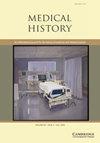Pierre-Yves Donzé, Medtech. The Formation and Growth of a Global Industry, 1960–2020 (Singapore: Palgrave MacMillan, 2022), pp. 230, £99.99, hardback, ISBN: 9789811671739.
IF 0.9
2区 哲学
Q4 HEALTH CARE SCIENCES & SERVICES
引用次数: 0
Abstract
Medtech. The Formation and Growth of a Global Industry, 1960–2020, by Pierre-Yves Donzé, is an ambitious new book from one of the best experts in the world on the business history of health of the twenty-first century. Once again, after a series of recent books and articles about the dynamics of the industry of medical equipment in Japan, Switzerland and Germany, Donzé opens the box for a new analysis, with new data, about the dynamics of such an industry in other regions of the world like the United States, France and China. Donzé acknowledges his intellectual debts: to authors who have recently appealed for the need to go beyond national approaches, and to efforts to establish international comparisons as was done in the recent book The Emergence of Modern Hospital Management and Organisation in theWorld.1 Donzé is a great specialist inmedical equipment, andwe knew fromhis work about the expansion of German equipment in the world in the last century. But now, Donzé goes beyond his expertise on X-rays and includes an identification of the main industrial players in the world over the last six decades, and the supply and demand factors that explain their success. The book starts with three general chapters about the dynamics of the global medtech industry, the dominance by big multinationals, the coexistence with clusters of smalland mid-sized enterprises and spin-off chains, as well as with themore personal networks of doctors and firms. He covers regulation by the state, the identity of the largest medtech players, the global trade of products of a very diversified industry and the wave of mergers and acquisitions that created a huge concentration of big players. All of this is important, not just to understand the endogenous features of the industry in a dynamic long-term perspective, but also to understand the directions of research and production in the industry. These are not always correlated with the directions that public health needs have had in history and today, reflected in the difficulties that states (and therefore, we) have had in regulating prices and access to the products of this industry. Anyone who needs to understand the rigidities faced by patients and consumers who need to access life-saving products and devices may find some clear answers and facts in these three chapters. A second group of six chapters approach from a national perspective the relationship between leading medtech corporations (exploring strategies of innovation and strategies of growth) and the market (mainly through foreign trade statistics). Onemisses somewhat in these chapters the role of the state and how public policies have allowed the creation of giants with an impressive capacity to impose: 1) research into certain illnesses, 2) production of some drugs and equipment over others, 3) prices and 4) investment in employment at the local level (or its financial outsourcing abroad unbalancing potential taxes they could pay at home with their outward direct investment strategies). The six chapters focus on the old key leading players (the United States, Germany, Japan and France); on new key players (China) and on intermediate very specialised niche market players like Switzerland. The sources are public and private records difficult to gather and still more difficult to present in an analytic and clear way as the author does in this very well written book. It is, indeed, an example for future researchers in the field. The reader may wish for additional chapters on other typologies of national approaches to the industry, including maybe examples of reverse innovation players in the medtech industry like India or Brazil. Or, one wonders, maybe the author could have written a chapter about what happened in the industry before World War II, when so many innovative companies and networks started that came to an end in the 1950s, with examples of countries where there had been very innovative medtech medium-sized players or networks of innovative scientists producing patents of world impact in the first half of the twentieth century, that had no commercial success in the distribution of their products abroad after the 1940s and 50s for diverse reasons. This was the case in Russia, for example, where paediatric incubators had been produced and introduced before the Revolution, but Stalin prohibited innovations皮埃尔·伊夫·唐泽尔,医疗科技公司。《全球产业的形成与成长,1960-2020》(新加坡:Palgrave MacMillan, 2022), 230页,99.99英镑,精装本,ISBN: 9789811671739。
医学技术。《全球产业的形成与成长,1960-2020》是一本雄心勃勃的新书,作者是世界上最好的21世纪健康商业史专家之一。在最近出版了一系列关于日本、瑞士和德国医疗设备行业动态的书籍和文章之后,donz再次打开了盒子,用新的数据对世界其他地区(如美国、法国和中国)的医疗设备行业动态进行了新的分析。donz承认自己在智力上欠了一些债,包括最近呼吁有必要超越国家方法的作者,以及建立国际比较的努力,就像最近出版的《世界上现代医院管理和组织的出现》一书中所做的那样唐泽尔是一位伟大的医疗设备专家,我们从他的工作中了解到上个世纪德国设备在世界上的扩张。但是现在,donz超越了他在x射线方面的专业知识,还包括对过去60年来世界上主要工业参与者的识别,以及解释他们成功的供需因素。这本书以三个总论章节开始,内容涉及全球医疗技术行业的动态、大型跨国公司的主导地位、中小企业集群和衍生链的共存,以及医生和公司之间更为个人化的网络。他涵盖了国家监管,最大的医疗技术公司的身份,一个非常多元化的行业的产品的全球贸易,以及创造了巨大集中的大公司的并购浪潮。这一切都很重要,不仅可以从动态的长远角度了解行业的内生特征,还可以了解行业的研究和生产方向。这些并不总是与历史上和今天的公共卫生需求的方向相关,这反映在各国(因此也是我们)在管制该行业产品的价格和获取方面遇到的困难上。任何需要了解需要获得救生产品和设备的患者和消费者所面临的刚性的人都可以在这三章中找到一些明确的答案和事实。第二组六章从国家的角度探讨领先的医疗技术公司(探索创新战略和增长战略)与市场(主要通过外贸统计)之间的关系。在这些章节中,有些人忽略了国家的角色,以及公共政策如何允许创造出具有令人印象深刻的能力的巨头:1)对某些疾病的研究,2)对某些药物和设备的生产,3)价格和4)在地方一级的就业投资(或其金融外包到国外,使他们在国内支付的潜在税收与他们的对外直接投资策略不平衡)。这六个章节聚焦于老的主要领导角色(美国、德国、日本和法国);在新的关键市场(中国)和中间非常专业的利基市场(如瑞士)。来源是公共和私人记录,很难收集,更难以以分析和清晰的方式呈现,就像作者在这本写得很好的书中所做的那样。这确实是该领域未来研究人员的一个范例。读者可能希望在其他章节中了解国家对该行业的其他类型,包括印度或巴西等医疗技术行业反向创新参与者的例子。或者,有人想知道,也许作者可以写一章关于第二次世界大战之前这个行业发生了什么,当时有很多创新的公司和网络开始在20世纪50年代结束,并举例说明那些在20世纪上半叶有非常创新的医疗技术中型企业或创新科学家网络产生世界影响的专利的国家,在20世纪40年代和50年代之后,由于各种原因,他们的产品在海外分销方面没有取得商业成功。例如,俄罗斯的情况就是这样,在革命之前,俄罗斯就生产并引进了儿科恒温箱,但斯大林禁止创新
本文章由计算机程序翻译,如有差异,请以英文原文为准。
求助全文
约1分钟内获得全文
求助全文
来源期刊

Medical History
医学-科学史与科学哲学
CiteScore
1.60
自引率
0.00%
发文量
25
审稿时长
>12 weeks
期刊介绍:
Medical History is a refereed journal devoted to all aspects of the history of medicine and health, with the goal of broadening and deepening the understanding of the field, in the widest sense, by historical studies of the highest quality. It is also the journal of the European Association for the History of Medicine and Health. The membership of the Editorial Board, which includes senior members of the EAHMH, reflects the commitment to the finest international standards in refereeing of submitted papers and the reviewing of books. The journal publishes in English, but welcomes submissions from scholars for whom English is not a first language; language and copy-editing assistance will be provided wherever possible.
 求助内容:
求助内容: 应助结果提醒方式:
应助结果提醒方式:


